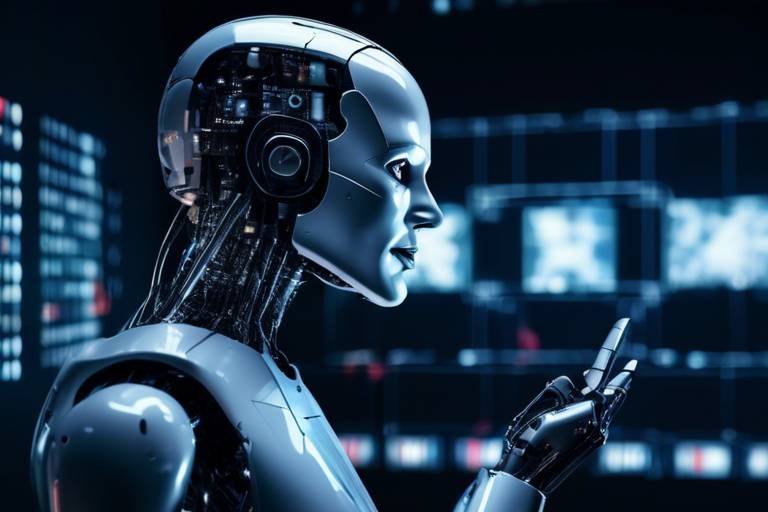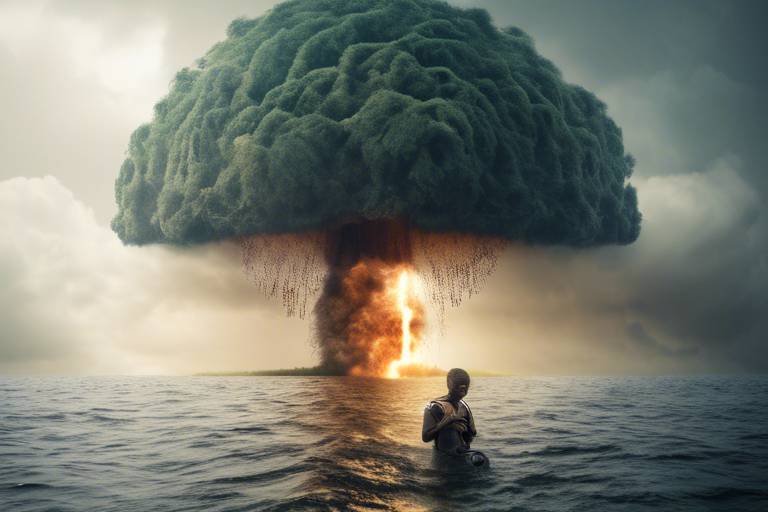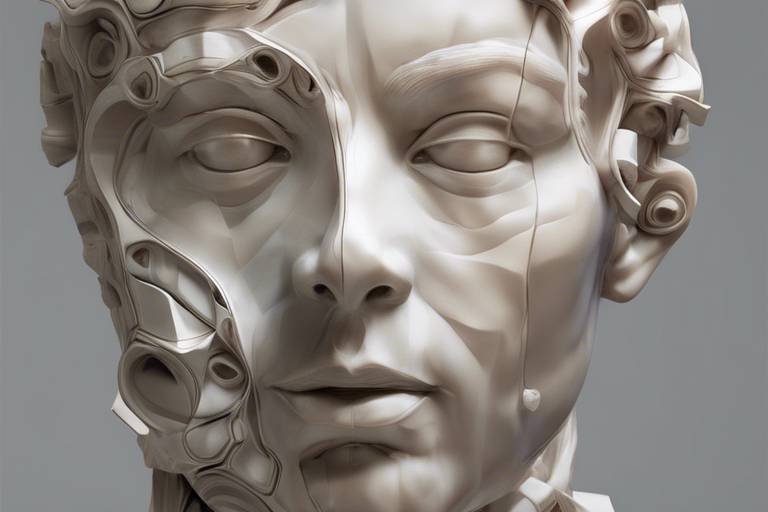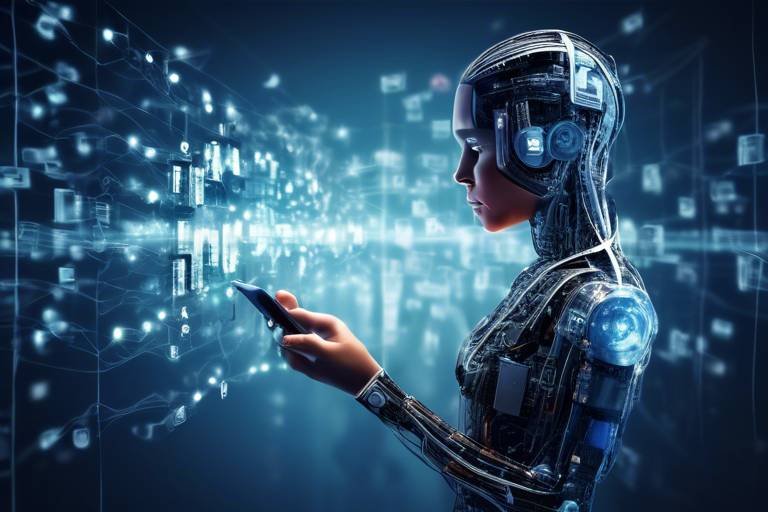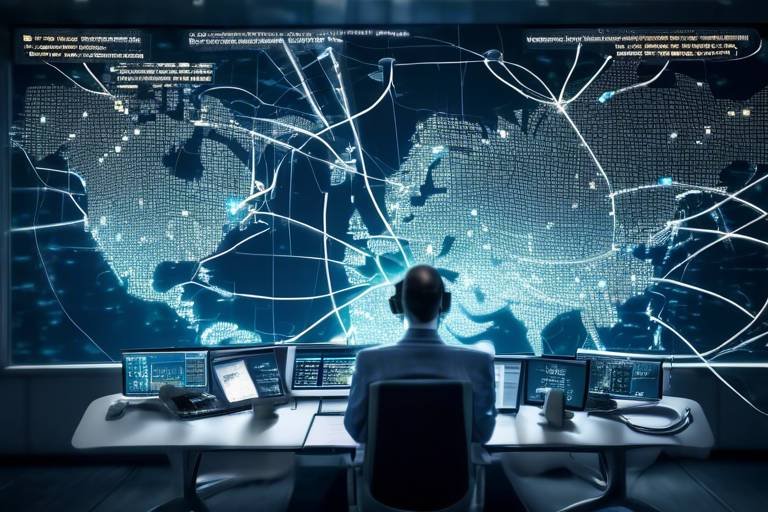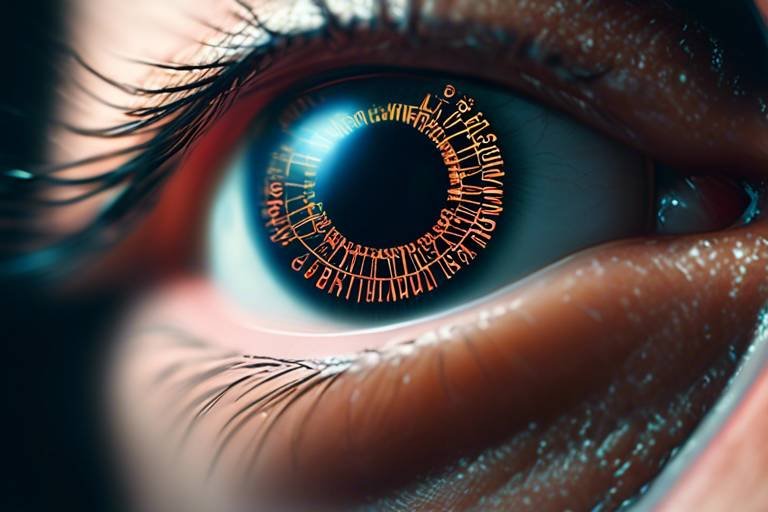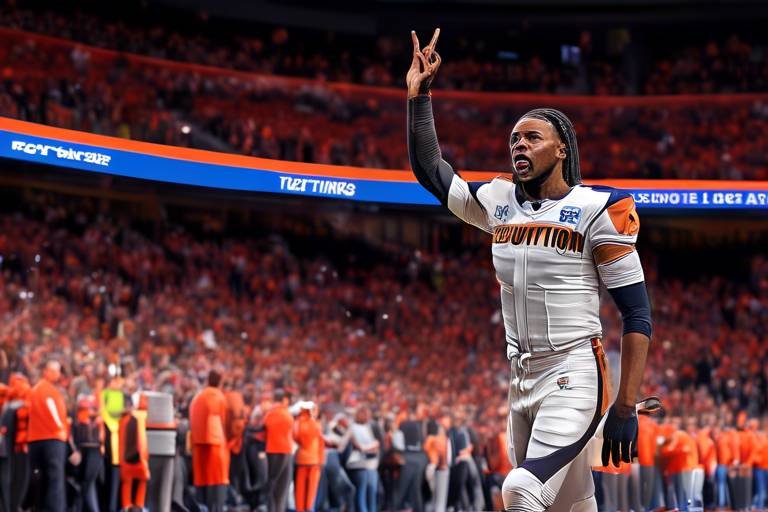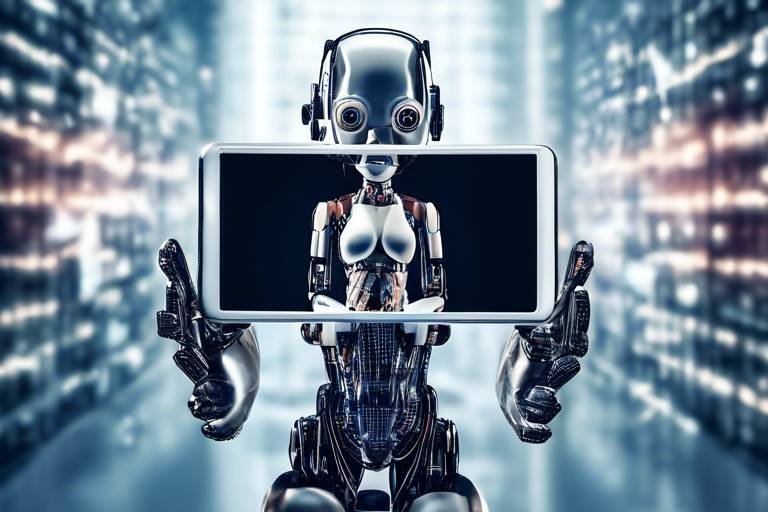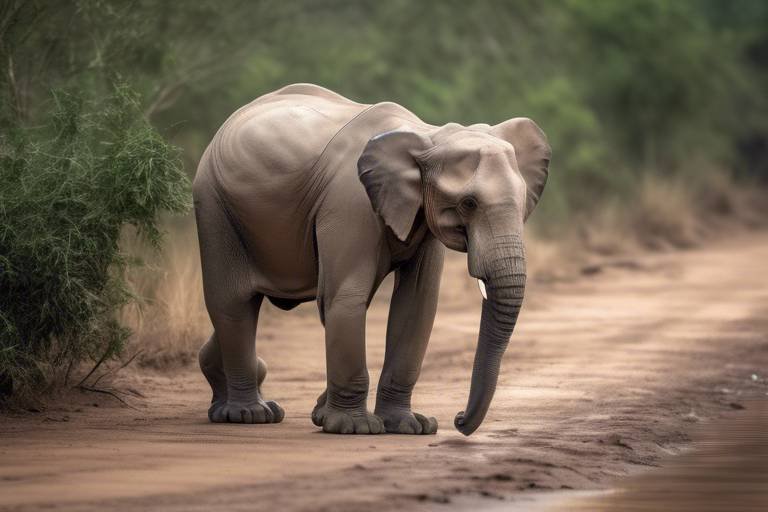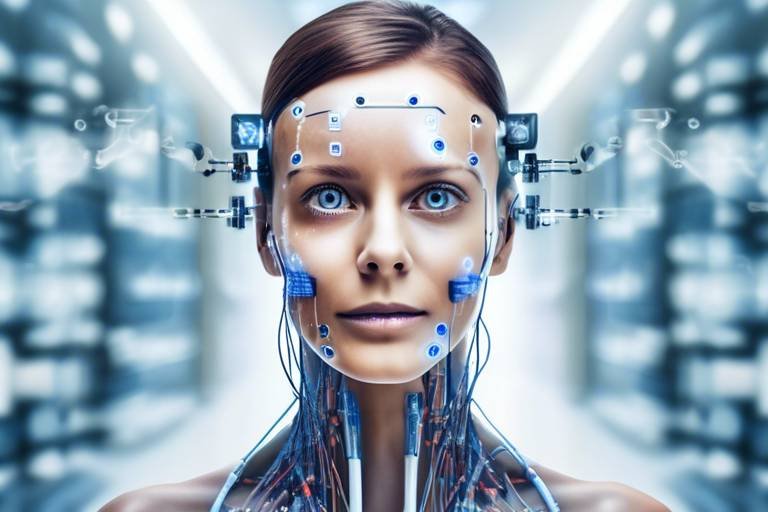The Growing Role of AI in Film Making
Have you ever wondered how technology is reshaping the world of cinema? The film industry has always been a playground for innovation, but the introduction of artificial intelligence (AI) is taking things to a whole new level. From scriptwriting to post-production, AI is not just a tool; it's becoming an essential partner in the creative process. Imagine a world where writers can brainstorm ideas with an intelligent assistant, directors can visualize scenes in real-time, and editors can produce polished films in record time. This is not a distant future; it's happening right now!
AI is transforming the way films are made, enhancing creativity and streamlining production processes. With its ability to analyze vast amounts of data, AI provides filmmakers with insights that were previously unimaginable. For instance, AI can suggest plot structures and dialogue that resonate with audiences, allowing writers to focus on the creative aspects of storytelling. It's like having a brainstorming buddy who never runs out of ideas!
Moreover, the integration of AI in casting decisions is revolutionizing how directors select their actors. By analyzing actor profiles and past performances, AI helps casting directors make informed choices that align perfectly with the film's vision and target audience. It’s a game-changer that not only saves time but also enhances the likelihood of a film's success at the box office.
As we delve deeper into the film production process, we see AI's impact extending to visual effects and animation. The ability to render scenes in real-time means that filmmakers can make immediate adjustments, fostering a collaborative environment that enhances creativity. Imagine being able to tweak a scene on the fly, making it even more spectacular without the long wait times associated with traditional rendering methods!
Finally, in the post-production phase, AI tools are streamlining editing, sound design, and color grading. Automated editing solutions can analyze footage and create rough cuts, allowing editors to focus on the artistic side of their craft. This not only speeds up the process but also ensures that the final product is polished and engaging.
In conclusion, the role of AI in filmmaking is not just about efficiency; it's about unlocking new levels of creativity and storytelling. As we continue to explore the capabilities of AI, the possibilities seem endless. The future of film is bright, and with AI by our side, we can expect to see stories that captivate, inspire, and entertain like never before.
- How is AI used in scriptwriting?
AI tools assist writers by providing ideas, plot structures, and dialogue suggestions, enhancing the creative process.
- Can AI help with casting decisions?
Yes, AI algorithms analyze actor profiles and performances, aiding casting directors in making informed choices that align with the film's vision.
- What role does AI play in visual effects?
AI enables faster rendering and more realistic simulations, allowing filmmakers to visualize scenes in real-time and make immediate adjustments.
- How does AI impact post-production?
AI tools assist with editing, sound design, and color grading, streamlining the process and improving the overall quality of the film.

AI in Scriptwriting
As the film industry evolves, artificial intelligence is stepping into the spotlight, particularly in the realm of scriptwriting. Imagine sitting at your desk, staring at a blank page, and feeling the weight of a million ideas swirling in your head. It’s daunting, right? But what if you had a smart assistant that could help you sift through those ideas, suggest plot structures, and even craft dialogue? That’s where AI comes into play, transforming the way writers approach storytelling.
AI tools are not just about generating random ideas; they are designed to enhance the creative process. By analyzing countless scripts and understanding the elements that resonate with audiences, these tools can provide insights that were previously only available through years of experience. For instance, an AI scriptwriting assistant can:
- Suggest character arcs based on successful narratives.
- Provide feedback on dialogue that feels authentic and engaging.
- Identify pacing issues within the script, helping maintain audience interest.
This technology acts like a collaborative partner, encouraging writers to think outside the box while also keeping them grounded in what has worked in the past. However, some might wonder: does this mean the end of the traditional screenwriter? Not at all! Think of AI as a creative ally rather than a replacement. It frees writers to focus on the big picture—developing unique stories and compelling characters—while the AI handles the more technical aspects of script development.
Moreover, AI can analyze audience preferences and trends by processing vast amounts of data from previous films. This means that writers can create scripts that are not only innovative but also aligned with what viewers are craving. For example, if a particular genre is gaining popularity, AI can highlight that trend, prompting writers to explore similar themes or styles. It’s like having a crystal ball that offers a glimpse into the future of storytelling!
As we look ahead, the integration of AI in scriptwriting is likely to become more sophisticated. Imagine AI systems that can learn from feedback and continuously improve their suggestions, adapting to the individual writer’s style and preferences. This could lead to a new era of personalized storytelling, where each script is not just a product of creativity but also a reflection of audience desires and market trends.
In conclusion, AI in scriptwriting is not just a technological advancement; it’s a revolution that enhances creativity, streamlines the writing process, and opens up new avenues for storytelling. As writers embrace these tools, they will find themselves empowered to create narratives that are not only compelling but also resonate deeply with audiences.
- How does AI assist in scriptwriting? AI tools provide suggestions for plot structures, character development, and dialogue, enhancing the creative process.
- Will AI replace human writers? No, AI is intended to be a collaborative tool that supports writers, not a replacement.
- Can AI predict audience preferences? Yes, AI can analyze data from past films to identify trends and preferences among viewers.

AI for Casting Decisions
In the ever-evolving landscape of filmmaking, casting decisions have always played a pivotal role in determining a film's success. With the advent of artificial intelligence, casting directors are now equipped with powerful tools that enhance their decision-making processes. Imagine being able to sift through thousands of actor profiles, performances, and audience reactions in a fraction of the time it would take a human. This is precisely what AI brings to the table, allowing for a more informed and strategic approach to casting.
One of the most exciting aspects of AI in casting is its ability to analyze actor profiles in depth. By examining an actor's previous roles, performance metrics, and even social media engagement, AI algorithms can provide insights that align with the film's vision and the target audience's preferences. This data-driven approach helps casting directors make choices that resonate more effectively with viewers, ultimately enhancing the film's box office potential.
Using data analytics, filmmakers can gain invaluable insights into current audience preferences and trends. This information allows them to tailor their casting choices in a way that not only fits the narrative but also attracts a larger audience. For instance, if data shows a growing interest in a particular genre or actor type, casting directors can adjust their selections accordingly. This alignment between casting and audience expectations can significantly boost a film's chances of success.
Advanced AI systems are capable of analyzing past performances of actors, offering a nuanced understanding of their strengths and weaknesses. These insights can be crucial in determining how well an actor might fit into a specific role. For example, if an actor has consistently excelled in dramatic roles, AI can flag them as a strong candidate for a similar character in a new project. This level of analysis not only aids casting decisions but also helps to ensure that the performances resonate with the audience.
One of the most fascinating applications of AI in casting is the use of predictive modeling. These tools can forecast the potential success of actors in particular roles based on various factors, including past box office performance and audience demographics. By leveraging this data, filmmakers can make strategic choices that could lead to greater audience engagement. Imagine knowing, even before the film is released, which actors are likely to draw in crowds based on historical data. This predictive capability is a game-changer in the world of casting.
In summary, the integration of AI in casting decisions is not just a trend; it's a revolution that is shaping the future of filmmaking. By combining data-driven insights with predictive analytics, casting directors are better equipped than ever to make choices that resonate with audiences and enhance the storytelling experience.
- How does AI help in casting decisions?
AI analyzes actor profiles and performance data to provide insights that help casting directors make informed choices. - Can AI predict the success of an actor in a role?
Yes, predictive modeling tools can forecast an actor's potential success based on historical data and audience trends. - Is AI replacing casting directors?
No, AI serves as a tool to assist casting directors, enhancing their decision-making processes rather than replacing them. - What kind of data does AI analyze for casting?
AI analyzes various data points including past performances, audience demographics, and social media engagement.

Data-Driven Casting Insights
In the ever-evolving landscape of filmmaking, the integration of artificial intelligence has ushered in a new era of . This innovative approach allows filmmakers to leverage vast amounts of data, enabling them to make more informed choices when it comes to selecting the right actors for their projects. Imagine being able to analyze audience preferences and trends with the precision of a finely tuned machine—this is the power that AI brings to the casting table.
By examining factors such as previous box office performances, social media engagement, and audience demographics, AI algorithms can provide invaluable insights into which actors might resonate with a specific target audience. For instance, if a film aims to attract a younger crowd, data analytics can highlight actors who have successfully connected with that demographic in past projects. This not only enhances the likelihood of box office success but also ensures that the casting aligns with the film's vision.
Moreover, AI can analyze historical data on film genres and actor success rates, offering filmmakers a comprehensive overview of potential casting choices. This analysis can be broken down into various categories, such as:
- Genre Trends: Which actors have historically performed well in specific genres?
- Audience Engagement: How do audiences respond to certain actors based on social media metrics?
- Demographic Insights: What age groups are drawn to particular actors, and how does this align with the film's target audience?
To illustrate the impact of data-driven casting, consider the following table that summarizes key insights from a recent analysis:
| Actor | Genre | Average Box Office Performance | Social Media Engagement Score |
|---|---|---|---|
| Actor A | Action | $200 million | 85% |
| Actor B | Romantic Comedy | $150 million | 75% |
| Actor C | Drama | $100 million | 90% |
This table illustrates how data can guide casting decisions, showcasing actors who not only have a strong box office history but also engage effectively with audiences on social media platforms. By tapping into these insights, filmmakers can craft a cast that not only aligns with their artistic vision but also appeals to the audience's preferences, ultimately enhancing the film's marketability.
As AI continues to evolve, it promises to refine the casting process further, allowing filmmakers to make decisions based on predictive analytics that forecast potential success. This shift towards data-driven insights is set to revolutionize the way casting decisions are made, ensuring that filmmakers are equipped with the tools they need to create compelling stories that resonate with audiences worldwide.
- How does AI analyze actor performance?
AI systems analyze past performances by reviewing various metrics, including box office success, audience ratings, and social media engagement. - Can AI replace casting directors?
While AI can provide valuable insights, the creative intuition and experience of casting directors remain irreplaceable in the decision-making process. - What are the benefits of data-driven casting?
Data-driven casting helps filmmakers make informed decisions, increases the likelihood of box office success, and aligns casting choices with audience preferences.

AI and Actor Performance Analysis
In the ever-evolving landscape of filmmaking, are playing a pivotal role in shaping the casting process. Imagine having a tool that can dissect an actor's past performances with the precision of a seasoned critic, evaluating their strengths and weaknesses in various roles. This is precisely what advanced AI systems are doing today. By analyzing extensive databases of film performances, AI can provide insights that were previously only available through subjective human judgment.
These AI systems utilize machine learning algorithms to sift through hours of footage, identifying patterns that reveal how an actor embodies different characters. For instance, they can assess an actor's emotional range, physicality, and even their chemistry with other actors. This data-driven approach ensures that casting directors make informed decisions that align with the vision of the film.
Moreover, the analysis can be broken down into several key areas:
- Emotional Range: AI can evaluate how convincingly an actor conveys emotions, which is crucial for roles that demand depth and authenticity.
- Physicality: The way an actor moves and interacts with their environment can be assessed to ensure they fit the physical demands of a role.
- Screen Presence: AI can analyze the charisma and magnetism an actor brings to the screen, which is often a significant factor in audience engagement.
Additionally, AI can aid in casting decisions by comparing potential candidates for a role against a library of successful performances. For example, if a filmmaker is looking for an actor to portray a complex villain, the AI can identify actors who have previously excelled in similar roles, providing a shortlist that enhances the likelihood of a successful casting choice.
Furthermore, the integration of AI in actor performance analysis is not just about finding the right fit for a role; it also opens up opportunities for diversity and inclusivity in casting. By relying on data rather than traditional biases, filmmakers can discover talent that may have been overlooked, thereby enriching the storytelling landscape.
In conclusion, as AI technology continues to advance, its application in actor performance analysis will likely become more sophisticated. This evolution not only streamlines the casting process but also enhances the overall quality of films, ensuring that audiences are treated to performances that resonate on a deeper level.
1. How does AI analyze actor performances?
AI analyzes actor performances by examining vast amounts of data from previous films, focusing on emotional range, physicality, and screen presence to provide insights for casting decisions.
2. Can AI replace casting directors?
While AI can assist in the casting process by providing data-driven insights, it cannot replace the intuition and creativity that casting directors bring to the table.
3. How does AI promote diversity in casting?
AI promotes diversity by minimizing biases in the casting process, allowing filmmakers to discover talent that might otherwise be overlooked based on traditional industry norms.

Predictive Modeling in Casting
Predictive modeling in casting is a game-changer for filmmakers looking to maximize their film's potential at the box office. This innovative approach leverages advanced algorithms and vast amounts of data to forecast how well an actor will perform in a specific role. Imagine having a crystal ball that not only tells you who might shine on screen but also predicts how the audience will react to their performance. Sounds magical, right? But it’s all grounded in data science and analytics.
At the heart of predictive modeling is the analysis of historical data, which includes past performances of actors, audience reactions, and even box office results from previous films. By examining these variables, filmmakers can identify patterns that reveal which actors resonate best with specific genres or character types. For instance, if a particular actor consistently draws in audiences for action-packed thrillers, predictive modeling can highlight their suitability for similar roles in upcoming projects.
Furthermore, predictive modeling can help filmmakers make strategic casting decisions that align with their creative vision and target audience. Here’s how it generally works:
- Data Collection: Data is gathered from various sources, including social media engagement, audience demographics, and past box office performances.
- Algorithm Development: Algorithms are designed to analyze the collected data, identifying trends and correlations that might not be immediately obvious.
- Simulation and Testing: Different casting scenarios are simulated to predict outcomes, allowing filmmakers to see how various actors might impact the film's success.
This process not only enhances the casting director's decision-making but also minimizes risks associated with casting choices. By relying on predictive analytics, filmmakers can avoid costly missteps that might arise from gut feelings or traditional casting methods. It's akin to having a seasoned mentor whispering in your ear, guiding you toward the best choices based on empirical evidence.
In a world where every dollar counts, especially in the competitive film industry, predictive modeling serves as a beacon of hope. It empowers filmmakers to cast actors who are not only talented but also likely to attract audiences, thus driving higher box office returns. This approach is rapidly becoming a standard practice, and those who embrace it are likely to stay ahead of the curve in an ever-evolving landscape.
What is predictive modeling in casting?
Predictive modeling in casting uses data analytics to forecast how well an actor will perform in a specific role, helping filmmakers make informed casting decisions.
How does predictive modeling benefit filmmakers?
It minimizes risks associated with casting choices by relying on empirical data, ensuring that selected actors resonate with the target audience and enhance box office potential.
What types of data are used in predictive modeling?
Data can include historical performance metrics, audience demographics, social media engagement, and past box office results.
Can predictive modeling guarantee a film's success?
While predictive modeling can significantly enhance the likelihood of success, it cannot guarantee it, as many factors influence a film's performance.

Enhancing Production Efficiency
In the fast-paced world of filmmaking, where every second counts and budgets can quickly spiral out of control, is more crucial than ever. Enter artificial intelligence (AI), the game-changer that is revolutionizing how films are made. Imagine a film set where repetitive tasks are automated, schedules are optimized, and resources are managed seamlessly. This isn't just a dream—it's becoming a reality thanks to AI technologies.
One of the most significant ways AI is streamlining production is through task automation. By automating mundane and repetitive tasks, such as scheduling meetings, managing location permits, or even tracking equipment, filmmakers can redirect their focus towards the creative aspects of production. For instance, AI-powered project management tools can analyze past projects and suggest optimal schedules, ensuring that each department has what it needs when it needs it. This not only saves time but also reduces stress for everyone involved.
Moreover, AI can analyze vast amounts of data to help filmmakers make better decisions. For example, predictive analytics can forecast potential delays based on historical data, allowing production teams to proactively address issues before they escalate. This data-driven approach is akin to having a crystal ball that provides insights into potential roadblocks, enabling teams to stay one step ahead.
Another fascinating aspect of AI in production is its ability to optimize resource management. With AI algorithms, filmmakers can track inventory in real-time, ensuring that materials and equipment are available when needed. Imagine a scenario where a director is halfway through shooting a scene, only to find out that a crucial piece of equipment is missing. AI can help mitigate such situations by alerting the team about the availability of resources and suggesting alternatives, thus keeping the production on track.
Furthermore, AI can enhance communication among team members. By utilizing AI-driven chatbots and communication platforms, crew members can receive instant updates about changes in the schedule or production needs. This real-time communication fosters a collaborative environment where everyone is informed and aligned, ultimately leading to a smoother production process.
In summary, the integration of AI in filmmaking is not just about making processes faster; it's about making them smarter. By enhancing production efficiency, filmmakers can focus more on storytelling and creativity rather than getting bogged down by logistical challenges. As we look to the future, the question isn't whether AI will play a role in filmmaking, but rather how filmmakers will harness its potential to create even more compelling stories.
- How does AI improve scriptwriting? AI tools can provide writers with plot suggestions and dialogue enhancements, making the writing process more efficient and creative.
- Can AI predict box office success? Yes, through data analytics and predictive modeling, AI can offer insights into audience preferences and potential film success.
- What are some examples of AI in visual effects? AI is used for real-time rendering and automating complex animation processes, resulting in high-quality visual storytelling.
- How does AI assist in post-production? AI tools streamline editing, sound design, and color grading, helping filmmakers achieve a polished final product more efficiently.

AI in Visual Effects
The film industry has always been a playground for innovation, and artificial intelligence (AI) is now the latest player in the game, particularly in the realm of visual effects (VFX). Imagine a world where the boundaries of creativity are pushed not just by human imagination but also by intelligent algorithms that can analyze, predict, and create stunning visuals. With AI, filmmakers are not just telling stories; they are crafting immersive experiences that captivate audiences in ways previously thought impossible.
One of the most exciting advancements AI has brought to visual effects is real-time rendering. Traditionally, rendering a scene could take hours or even days, often leaving filmmakers in a state of suspense, wondering how their vision will translate on screen. However, with AI-driven rendering engines, this process has been revolutionized. Filmmakers can now visualize scenes in real-time, receiving immediate feedback and making adjustments on the fly. This not only enhances the creative process but also fosters a collaborative environment where ideas can be tested and modified instantaneously.
Furthermore, AI is making a significant impact on animation techniques. In the past, animators spent countless hours on repetitive tasks, such as creating in-between frames or adjusting movements. With the integration of AI, these tedious processes can now be automated, allowing animators to focus on what truly matters: creativity. By leveraging machine learning algorithms, AI can understand styles and movements, generating high-quality animations that resonate with audiences while saving time and resources.
Another fascinating application of AI in visual effects is its ability to enhance the realism of simulations. Whether it's creating lifelike water effects, realistic explosions, or even the intricate movements of crowds, AI algorithms can analyze vast amounts of data to produce more accurate and visually stunning results. For example, AI can simulate physics-based effects that mimic real-world behavior, making scenes more believable and engaging.
To illustrate the impact of AI on visual effects, consider the following table showcasing some key benefits:
| Benefit | Description |
|---|---|
| Speed | Real-time rendering allows for immediate feedback, drastically reducing production time. |
| Quality | AI enhances the realism of visual effects, creating lifelike simulations. |
| Creativity | Automating repetitive tasks frees up creative energy for animators and filmmakers. |
| Cost-Effectiveness | Streamlined processes lead to reduced costs and resource management. |
As we look to the future, the role of AI in visual effects is only expected to grow. With advancements in deep learning and neural networks, filmmakers will be equipped with tools that not only enhance their creative capabilities but also open new avenues for storytelling. Imagine a world where entire landscapes, characters, and effects can be generated with a simple command, allowing filmmakers to bring their wildest dreams to life without the constraints of traditional methods.
In conclusion, AI is not just a tool; it is a transformative force in the film industry, particularly in visual effects. It empowers filmmakers to push the envelope of creativity, making the impossible possible. As technology continues to evolve, who knows what breathtaking visuals and captivating stories await us in the near future? One thing is for sure: the marriage of AI and visual effects is just beginning, and the results are bound to be nothing short of spectacular.
- How is AI changing the visual effects industry?
AI is streamlining rendering processes, enhancing animation, and improving the realism of simulations, thus revolutionizing how visual effects are created. - What are the benefits of real-time rendering?
Real-time rendering allows filmmakers to see immediate results, enabling quicker decision-making and fostering a more collaborative creative environment. - Can AI fully replace human animators?
While AI can automate repetitive tasks, the creative vision and artistry of human animators remain irreplaceable, allowing for unique storytelling that resonates with audiences. - What future advancements can we expect from AI in visual effects?
Future advancements may include more sophisticated simulations, improved predictive algorithms for audience engagement, and potentially, fully automated visual effects creation.

Real-Time Rendering with AI
Imagine being able to see your film's scenes come to life in real-time, right before your eyes. This is no longer a far-fetched dream; it's the exciting reality brought to us by artificial intelligence. Real-time rendering with AI allows filmmakers to visualize their creative ideas instantly, making the production process not just faster, but also more collaborative and innovative. Instead of waiting hours or even days for a rendered scene to appear, directors and cinematographers can now receive immediate feedback, enabling them to make quick adjustments and enhancements on the spot.
One of the most significant benefits of real-time rendering is the ability to experiment freely. Filmmakers can play with lighting, textures, and camera angles without the usual delays associated with traditional rendering methods. This not only fuels creativity but also fosters a dynamic environment where ideas can flow freely. The integration of AI in this process means that the rendering engines are smarter than ever, capable of understanding the artistic vision and making suggestions that align with it.
Moreover, real-time rendering enhances the collaborative aspect of filmmaking. Teams can work together in a shared virtual space, making decisions that are informed by what they see rather than what they imagine. This collaboration can lead to a more cohesive final product, as everyone involved can contribute their insights and ideas based on the visualized scenes. The technology is particularly beneficial in pre-visualization, where filmmakers can create a rough draft of their scenes, allowing them to plan shots and movements before actual filming begins.
To illustrate the impact of AI-driven real-time rendering, consider the following table that highlights key benefits:
| Benefit | Description |
|---|---|
| Instant Feedback | Filmmakers can see changes in real-time, allowing for immediate adjustments. |
| Enhanced Collaboration | Teams can work together in a shared virtual space, improving communication. |
| Creative Freedom | Experimentation with different visuals and effects becomes easier and faster. |
| Efficient Pre-Visualization | Filmmakers can plan and visualize scenes before actual shooting, saving time. |
In summary, real-time rendering powered by AI is revolutionizing the film industry by making the creative process more efficient and collaborative. As technology continues to evolve, we can only imagine the new heights filmmakers will reach, crafting stories that captivate audiences like never before.
- What is real-time rendering? Real-time rendering is the process of generating images from 3D models at a speed that allows for immediate feedback, making it ideal for filmmaking and animation.
- How does AI enhance real-time rendering? AI enhances real-time rendering by optimizing rendering processes, predicting visual outcomes, and allowing for dynamic adjustments during the creative process.
- Can real-time rendering be used for live-action films? Yes, real-time rendering can be integrated into live-action films, especially in scenes requiring extensive visual effects or virtual environments.

AI and Animation Techniques
Artificial Intelligence is not just a buzzword; it’s a game-changer in the world of animation. Imagine a bustling animation studio where artists are no longer bogged down by tedious, repetitive tasks. Instead, they can focus their creativity on crafting captivating stories and characters. That’s the magic of AI in animation! By automating complex processes, AI allows animators to unleash their artistic potential. This transformation is akin to having a supercharged assistant that takes care of the mundane while you get to play in the sandbox of creativity.
One of the most significant impacts of AI in animation is its ability to streamline the production pipeline. Traditional animation often requires painstaking attention to detail, with animators manually creating frames and adjusting movements. However, AI-driven tools can now analyze motion and suggest realistic movements, making the animation process not only faster but also more accurate. For instance, AI algorithms can learn from existing animations and generate new sequences that maintain the same style and fluidity. This is particularly useful in projects like animated films or series where consistency is key.
Moreover, AI can enhance character rigging and modeling. In the past, creating a character model could take weeks, but with AI algorithms, this process is significantly shortened. By utilizing machine learning, AI can understand the anatomy of characters and automatically generate rigged models that are ready for animation. This means that animators can spend less time on technical aspects and more time on storytelling and character development. The result? Richer narratives and more engaging characters that resonate with audiences.
Another fascinating application of AI in animation is its role in generating backgrounds and environments. Imagine a lush forest or a bustling cityscape that comes to life without the painstaking effort of drawing every leaf or brick. AI can create stunning environments by analyzing existing images and generating new ones that fit the desired aesthetic. This not only saves time but also allows for a greater variety of settings within a single project. As a result, filmmakers can craft visually stunning worlds that captivate viewers and enhance the overall storytelling experience.
In conclusion, the integration of AI into animation techniques is revolutionizing the industry. It empowers animators to focus on their creative vision while AI handles the heavy lifting. This collaboration between human creativity and machine efficiency is paving the way for a new era of animation, where the possibilities are as limitless as the imagination itself. As we continue to explore the potential of AI, we can only anticipate the breathtaking innovations that lie ahead in the realm of animated storytelling.
- How does AI improve animation quality?
AI enhances animation quality by automating repetitive tasks, allowing animators to focus on creativity. It can also analyze and mimic realistic movements, ensuring fluidity and consistency in animations. - Can AI create entire animated films?
While AI can assist in generating content and automating tasks, human creativity is still essential for storytelling and character development in animated films. - What are the limitations of AI in animation?
AI may struggle with nuanced emotional expressions or complex storytelling elements that require a deep understanding of human experiences, which still relies on human input.

AI in Post-Production
In the world of filmmaking, the post-production phase is where the magic truly happens. This is the stage where all the pieces come together, and the film starts to take its final shape. However, traditional post-production can be a time-consuming and labor-intensive process. Enter artificial intelligence, a game-changer that is revolutionizing how filmmakers approach editing, sound design, and color grading. By leveraging AI tools, filmmakers can enhance their workflow, allowing them to focus more on creativity while machines handle the heavy lifting.
One of the most significant advancements in AI for post-production is in the realm of automated editing solutions. Imagine having software that can analyze hours of footage and generate rough cuts in a fraction of the time it would take a human editor. This is not a distant dream; it’s a reality today. AI-powered editing software utilizes complex algorithms to identify the best takes, ensuring that the film's narrative flows seamlessly. This not only speeds up the editing process but also allows editors to concentrate on the finer details that require a human touch, such as pacing and emotional impact.
Moreover, AI is making waves in sound design. The auditory experience of a film is just as crucial as the visual one, and AI technologies are stepping up to enhance this aspect significantly. For instance, AI tools can assist in creating sound effects that are not only realistic but also tailored to fit the mood and tone of specific scenes. They can analyze the audio landscape of a film and suggest enhancements for dialogue clarity or background sounds, ensuring that every auditory element contributes to the storytelling.
Additionally, color grading, an essential part of post-production, is being transformed by AI as well. Traditionally, color grading requires a keen eye and extensive expertise to achieve the desired visual style. However, AI can analyze the footage and suggest color palettes that align with the film’s themes and emotions. This means that filmmakers can achieve a polished look more efficiently, without compromising on quality. The integration of AI in color grading not only saves time but also opens up new avenues for creative expression.
To give you a clearer picture of how AI is shaping post-production, let’s take a look at some of the key benefits:
| Benefit | Description |
|---|---|
| Time Efficiency | AI tools can drastically reduce the time spent on editing and sound design, allowing for quicker turnaround times. |
| Enhanced Creativity | By automating repetitive tasks, filmmakers can focus more on the creative aspects of their projects. |
| Improved Quality | AI can analyze and suggest improvements, resulting in a more polished final product. |
| Cost Reduction | Streamlined processes can lead to lower overall production costs. |
The future of post-production is undeniably bright with the rise of AI technologies. As these tools continue to evolve, they will further enhance the filmmaking process, allowing creators to push the boundaries of their art. The integration of AI not only makes post-production more efficient but also enriches the overall narrative experience for audiences. So, whether you're a filmmaker or a film enthusiast, keep an eye on how AI is shaping the future of cinema—it’s a thrilling ride!
- How does AI improve the editing process? AI improves editing by automating repetitive tasks, allowing editors to focus on creative decisions and speeding up the overall process.
- Can AI tools enhance sound design? Yes, AI tools can analyze audio and suggest enhancements for sound effects and dialogue, improving the overall sound quality of a film.
- Is AI capable of color grading? Absolutely! AI can analyze footage and suggest color palettes that align with the film's themes, making color grading more efficient.
- What are the cost benefits of using AI in post-production? By streamlining processes, AI can reduce labor costs and shorten production timelines, ultimately leading to lower overall costs.

Automated Editing Solutions
In the fast-paced world of filmmaking, time is money, and the editing phase can often feel like a never-ending labyrinth of footage and decisions. Enter , the game-changer that is revolutionizing how filmmakers approach post-production. Imagine having a virtual assistant that can sift through hours of raw footage, identifying the best takes, and assembling them into a coherent narrative. Sounds like something out of a sci-fi movie, right? But this is the reality we are stepping into.
AI-powered editing software is designed to analyze footage using advanced algorithms that recognize patterns, emotions, and even dialogue. This means that instead of spending countless hours manually reviewing each scene, editors can rely on these intelligent systems to create rough cuts in a fraction of the time. The beauty of this technology lies not only in its efficiency but also in its ability to enhance the creative process. With the mundane tasks handled by AI, editors can focus on what they do best: crafting a compelling story.
Some of the key features of automated editing solutions include:
- Smart Scene Detection: Automatically identifies and categorizes scenes based on visual and audio cues, making it easier to locate specific moments in the footage.
- Emotion Recognition: Analyzes actors' performances to determine emotional intensity, helping editors choose the most impactful takes.
- Automated Transitions: Suggests seamless transitions between scenes, ensuring a smooth flow that keeps viewers engaged.
Moreover, these solutions can also integrate with other AI technologies, such as sound design and color grading tools, creating a cohesive ecosystem that enhances the overall production quality. For instance, while the editing software is busy crafting the visual narrative, sound design AI can simultaneously work on enhancing audio elements, ensuring that every aspect of the film is polished to perfection.
As we embrace these automated solutions, it’s essential to remember that they are not here to replace human editors but to empower them. The fusion of AI and human creativity can lead to breathtaking results, where technology acts as a collaborator rather than a competitor. This synergy allows filmmakers to push the boundaries of storytelling, creating films that resonate deeply with audiences.
- What are automated editing solutions?
Automated editing solutions are AI-powered tools that assist filmmakers in the editing process by analyzing footage, identifying key scenes, and creating rough cuts, significantly speeding up post-production. - How do these solutions enhance creativity?
By handling repetitive tasks, automated editing solutions free up editors to focus on creative decisions, allowing them to craft a more compelling narrative. - Can automated editing tools replace human editors?
No, these tools are designed to assist and enhance the work of human editors, not to replace them. The creative vision and storytelling ability of human editors remain irreplaceable.

AI for Sound Design
In the realm of filmmaking, sound is often the unsung hero, playing a pivotal role in shaping the viewer's experience. With the advent of artificial intelligence, sound design is undergoing a remarkable transformation, elevating the auditory experience to new heights. Imagine a world where sound effects are not just added but are intricately woven into the narrative, enhancing every moment of the film. AI technologies are stepping in to make this a reality, offering innovative solutions that are changing the way filmmakers approach sound.
One of the most exciting developments in AI for sound design is its ability to analyze audio data and generate sound effects that are tailored to specific scenes. For example, AI algorithms can study the emotional tone of a scene and produce soundscapes that resonate with the underlying themes. This means that instead of relying solely on traditional sound libraries, sound designers can create unique auditory experiences that perfectly match the film's mood. The result? A more immersive experience for the audience that draws them deeper into the story.
Moreover, AI is proving to be an invaluable tool in dialogue enhancement. Have you ever watched a film and struggled to catch the dialogue over background noise? AI technologies can analyze audio tracks to isolate dialogue, removing unwanted noise and ensuring that every word is crystal clear. This not only improves the overall sound quality but also enhances the storytelling by making sure that the audience doesn't miss crucial plot points.
Another fascinating aspect of AI in sound design is its role in music composition. AI algorithms can analyze existing musical scores and generate new compositions that match the emotional trajectory of a film. This means that filmmakers can have access to a virtually limitless supply of original music that can be tailored to their specific needs. Imagine having a unique soundtrack that evolves with the story, capturing the essence of each scene without the lengthy process of collaborating with composers. This not only saves time but also opens up new creative avenues for filmmakers.
To illustrate the impact of AI on sound design, consider the following table that highlights the key advantages:
| AI Applications | Benefits |
|---|---|
| Sound Effect Generation | Creates unique soundscapes tailored to scenes |
| Dialogue Enhancement | Isolates dialogue for clarity, improves sound quality |
| Music Composition | Generates original scores that match film emotions |
As we look to the future, it’s clear that AI will continue to play a crucial role in sound design. By automating routine tasks and providing advanced analytical capabilities, AI allows sound designers to focus on the creative aspects of their work. This shift not only enhances the quality of sound in films but also contributes to a more dynamic and engaging storytelling experience.
So, as you settle down to enjoy your next movie, take a moment to appreciate the intricate sound design that brings the film to life. Thanks to AI, the sounds you hear are no longer mere background noise; they are an integral part of the cinematic experience, crafted with precision and creativity.
- How does AI enhance sound design in films?
AI enhances sound design by generating tailored sound effects, improving dialogue clarity, and creating original music compositions that align with the film's emotional tone. - Can AI completely replace human sound designers?
While AI can automate many tasks and provide innovative tools, human creativity and intuition remain essential in crafting a compelling auditory experience. - What are some examples of AI tools used in sound design?
Some popular AI tools include Adobe Audition for audio editing, AIVA for music composition, and Descript for dialogue enhancement.
Frequently Asked Questions
- How is AI changing the scriptwriting process in filmmaking?
AI tools are revolutionizing scriptwriting by providing writers with creative ideas, plot structures, and dialogue suggestions. This technology enhances the storytelling process, making it more efficient and allowing writers to explore new concepts they might not have considered before.
- What role does AI play in casting decisions?
Casting directors are using AI algorithms to analyze actor profiles and past performances, which helps them make informed decisions that align with the film's vision and audience preferences. This data-driven approach ensures that casting choices resonate well with viewers.
- Can AI predict the success of actors in specific roles?
Yes! AI employs predictive modeling tools that forecast how well an actor might perform in a particular role. This helps filmmakers make strategic casting choices that can lead to greater audience engagement and box office success.
- How does AI enhance production efficiency?
AI technologies streamline production processes by automating repetitive tasks, optimizing schedules, and managing resources effectively. This not only reduces costs but also significantly improves the overall efficiency of film projects.
- What advancements has AI brought to visual effects?
AI is transforming visual effects by enabling faster rendering and more realistic simulations. AI-driven rendering engines allow filmmakers to visualize scenes in real-time, facilitating immediate feedback and adjustments, which enhances creative collaboration during production.
- How is AI used in animation?
AI automates complex animation processes, allowing animators to focus on the creative aspects of their work while machines handle repetitive tasks. This results in higher-quality animated content and a more efficient workflow.
- What are the benefits of AI in post-production?
In post-production, AI tools assist with editing, sound design, and color grading, making it easier and faster to achieve a polished final product. AI-powered editing software can analyze footage and create rough cuts, allowing editors to concentrate on creative decisions instead of getting bogged down in technical details.
- How does AI enhance sound design in films?
AI technologies enhance sound design by offering innovative solutions for sound effects, dialogue enhancement, and music composition. This not only elevates the overall film experience but also allows sound designers to experiment with new techniques that were previously time-consuming or difficult.

